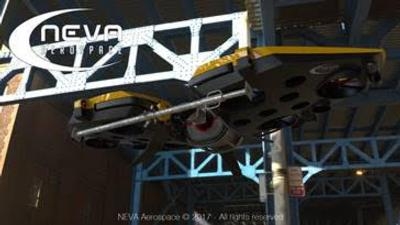Wed, Mar 29, 2017
Launch Of First VTOL-Optimized Turbines Proved Technology Behind Patented Distributed Thrust Approach
Heavy duty aerial robots have made a major leap from wish-tech to becoming next generation real-tech innovation after the success of early aeronautical engineering development work by Neva Aerospace. Having secured essential international patent protection of its concepts, the company is now sharing its ideas for aerial robotic platforms (ARPs) with the public announcement of its Vlinder concept. ARPs will meet demand from industrial operators who need to find ways to complement human workforces for maintenance and engineering work in dull, dirty, distant and dangerous locations.

While current generation camera and survey drones weigh just a few Kg and have very limited flight endurance, the Neva project is looking towards heavy duty drones, with the flight endurance to work beyond line of sight controlled by flight management systems, and the stability to act as steady platform for on-board robots carrying out precision work. Payloads of up to 2 metric tons are envisaged.
Neva’s inherently-safe and sustainable and scalable technology for ARPs is based on the use of distributed thrust from multiple hybrid ducted electric turbofans(ETF). Using many ETF of different sizes and with precise orientation aids precision control and allows for redundancy.
The Neva turbines that are now being used by the Neva team for its own test prototypes and that will be built into future Vlinder ARPs are based on the company’s own highly-efficient and powerful patented static thrust designs. Neva announced the world’s first electric static thrust turbofans (ETF) optimized for VTOL and stable hovering at the end of 2016. It is now making this breakthrough available to the OEM market where Neva believes its turbines will eventually and inevitably displace unsafe and uncaged propellers if the commercial UAS market is to win acceptance in urban areas and civil airspace.
“The Neva project started in 2009 and we understand that there are no short cuts or quick fixes. We are not in the PR business of announcing systems that are neither technically nor economically viable," said Neva Aerospace chairman Robert Vergnes. “We are on a long journey and one which we cannot navigate alone – we work in partnership with other technology providers and with the organizations that will use this technology to customise designs that can be fully integrated into their enterprise.
“We have of course been talking to such firms over the years, but it is only now we have come to the end of a long process of securing patent protection that we can share our ideas more publicly. This enables us to demonstrate the logic and soundness of the Neva vision for heavy duty workhorse drones.”
(Image provided with Neva Aerospace news release)
More News
The Industry Continues to be Rocked By Some Questionable Operations Recent investigations and a great deal of data has resulted in ANN’s SportPlane Resource Guide’s rep>[...]
Make Sure You NEVER Miss A New Story From Aero-News Network Do you ever feel like you never see posts from a certain person or page on Facebook or Instagram? Here’s how you c>[...]
Visual Approach Slope Indicator (VASI) An airport lighting facility providing vertical visual approach slope guidance to aircraft during approach to landing by radiating a directio>[...]
Airport Marking Aids Markings used on runway and taxiway surfaces to identify a specific runway, a runway threshold, a centerline, a hold line, etc. A runway should be marked in ac>[...]
Aero Linx: The Skyhawk Association The Skyhawk Association is a non-profit organization founded by former Skyhawk Pilots which is open to anyone with an affinity for the A-4 Skyhaw>[...]
 Unfortunate... ANN/SportPlane Resource Guide Adds To Cautionary Advisories
Unfortunate... ANN/SportPlane Resource Guide Adds To Cautionary Advisories ANN FAQ: Turn On Post Notifications
ANN FAQ: Turn On Post Notifications ANN's Daily Aero-Term (04.29.24): Visual Approach Slope Indicator (VASI)
ANN's Daily Aero-Term (04.29.24): Visual Approach Slope Indicator (VASI) ANN's Daily Aero-Term (04.28.24): Airport Marking Aids
ANN's Daily Aero-Term (04.28.24): Airport Marking Aids ANN's Daily Aero-Linx (04.28.24)
ANN's Daily Aero-Linx (04.28.24)



